(this page is updated periodically)
Targeted groups: AfricanLatinx NativeAsian All POC
Note: Where policies and practices impact all People of Color, those with darker skin tone are often affected most.
1492-1700
1492-1700European Impact on Native Population
- The Smithsonian Institute at the National Museum of the American Indian in Washington D.C. estimates that 9 out of 10 indigenous people perished during the first two centuries after first contact between Europeans and the inhabitants of the Western Hemisphere due to disease and violence.
- Conservative estimates of the native population of North American (north of the Rio Grande) are seven to ten million, with some estimating as many as 19 million. There were roughly six hundred tribes and they spoke diverse dialects. Citation
- By 1900 there were fewer than 300,000 Native Americans still living in the area now considered to be the United States.
1600’s
1600's
Indentured Servants
- From the 1600’s on, because of the need for labor in the colonies, many men between the ages of 15-22 were able to come to the colonies through an indentured agreement. This allowed the men to pay off their passage through their time as indentured servants.
- Their passage could be paid off in seven years.
- During the 17th century, indentured servants suffered an appalling death rate. Half of all white servants in the Chesapeake colonies of Virginia and Maryland died within five years of their arrival. Since servants cost half as much as slaves, they were a more economical investment.
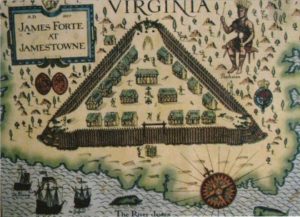
First English Settlement
-
- The Lost Colony of Roanoke, established in 1585, failed and no colonizers were ever found.
- Jamestown was the first permanent English Settlement – established by the Virginia Company of London, May 4, 1607.
- Jamestown survived due in large part to welcoming from the Natives who supplied the colonizers with crucial provisions. The Natives themselves were not “agriculturally inclined.”
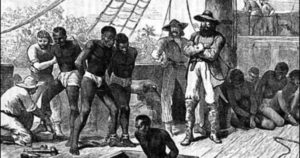
First Imported Africans
In August of 1619 a Dutch man-of-war with about 20 Africans on board entered port at the English colony of Jamestown, Virginia. Little is known of these newly arrived people: the first Africans to set foot on the North American continent. At this time the slave trade between Africa and the English colonies had not yet been established, and it is unlikely that the 20 or so newcomers became slaves upon their arrival. They were perhaps considered indentured servants, who worked under contract for a certain period of time (usually seven years) before they were granted freedom and the rights accorded to other settlers.
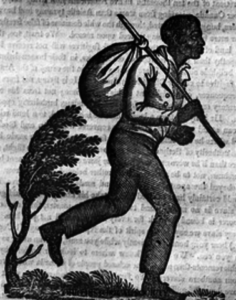
Life Long Servitude
John Punch, James Gregory, and a man named Victor were all indentured servants contracted to Virginia planter Hugh Gwyn. These three men each performed similar tasks as slaves and each also felt so exploited he was willing to take unimaginable risks to pursue freedom. John, James, and Victor ran away and were captured within days.
Though fleeing similar circumstances, the fates of the runaways differed under the court’s aegis. A judge sentenced all three to whippings. He then added four years to the indenture terms of James and Victor, both white Europeans. John, a black man, he condemned to lifelong servitude.
John Punch is one of the first servants on record to be sentenced to slavery on the grounds of race. However, he was neither the first nor the last black man to flee from oppressive bondage. Despite the development of harsh fugitive slave laws in the next century, running away remained one of the most common strategies for escaping slavery.
Read a transcript of the original court decision on Gwyn’s case against Punch and his companions.
Runaways and Insurrection
The 1642 Virginia act against runaways and the 1680 act against insurrection reflect the harsh punishments that awaited not only slaves who rebelled, but also slaves perceived as potential intransigents. When slaves sought to escape captivity by running away or fighting back, they faced a range of punishments including branding, lashing, and death. Although the 1642 act acknowledges that mistreatment at the hands of a master might inspire flight, it promises little support for the abused slave. (See 1660
ACT XXII: 1. 254 CHARLES I, King of England)
State Sponsored Education
The General Court of the Massachusetts Bay Colony decreed that every town of fifty families should have an elementary school and that every town of 100 families should have a Latin school. The goal was to ensure that Puritan children learn to read the Bible and receive basic information about their Calvinist religion.
Compiled by Elaine Rector as part of CFEE (Coaching for Educational Equity) contact elrector@comcast.net
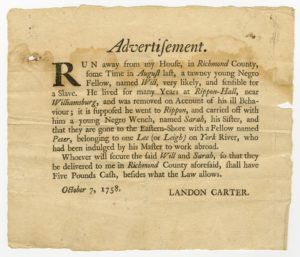
Harsher Runaway Laws
The General Assembly passed laws (as early as 1643) that established penalties for runaway slaves and servants, regulated their movement, identified multiple offenders (by branding them or cutting their hair), and provided rewards for their capture.

Slavery Becomes Inheritable
Elizabeth Key, an indentured servant, was sold as a servant, but treated as a slave by her new owner. She sued for her freedom and the House of Burgesses ruled in her favor.
Later, that same court passed a law to prevent such occurrences (not of mistreatment, but of servants or slaves being able to sue for freedom): the status of a child was now determined by the mother’s status. Slavery became an inheritable condition for people of African descent. Laws and rulings ensured that white property owners would have a permanent work force—one bound to them by law, custom and, increasingly, race.
Baptism Does Not Free Slaves
The General Assembly of the colony of Virginia attempts to better define the conditions by which people were enslaved or free:
WHEREAS some doubts have risen whether children that are slaves by birth, and by the charity and piety of their owners made pertakers of the blessed sacrament of baptisme, should by vertue of their baptisme be made ffree; It is enacted and declared by this grand assembly, and the authority thereof, that the conferring of baptisme doth not alter the condition of the person as to his bondage or ffreedome; that diverse masters, ffreed from this doubt, may more carefully endeavor the propagation of christianity by permitting children, though slaves, or those of greater growth if capable to be admitted to that sacrament.
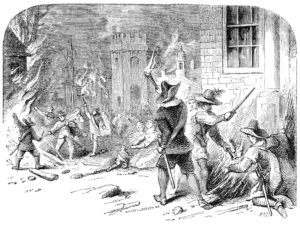 Bacon’s Rebellion was an armed rebellion in 1676 by Virginia settlers led by Nathaniel Bacon against the rule of Governor William Berkeley. The colony’s dismissive policy as it related to the political challenges of its western frontier, along with other challenges including leaving Bacon out of his inner circle, refusing to allow Bacon to be a part of his fur trade with Native Americans, and attacks by the Doeg people, helped to motivate a popular uprising against Berkeley, who had failed to address the demands of the colonists regarding their safety.
Bacon’s Rebellion was an armed rebellion in 1676 by Virginia settlers led by Nathaniel Bacon against the rule of Governor William Berkeley. The colony’s dismissive policy as it related to the political challenges of its western frontier, along with other challenges including leaving Bacon out of his inner circle, refusing to allow Bacon to be a part of his fur trade with Native Americans, and attacks by the Doeg people, helped to motivate a popular uprising against Berkeley, who had failed to address the demands of the colonists regarding their safety.
Thousands of Virginians from all classes and races rose up in arms against Berkeley, attacking Native Americans, chasing Berkeley from Jamestown, Virginia, and ultimately torching the capital. The rebellion was first suppressed by a few armed merchant ships from London whose captains sided with Berkeley and the loyalists. Government forces from England arrived soon after and spent several years defeating pockets of resistance and reforming the colonial government to be once more under direct royal control.
It was the first rebellion in the American colonies in which discontented frontiersmen took part (a somewhat similar uprising in Maryland involving John Coode and Josias Fendall took place shortly afterwards). The alliance between European indentured servants and Africans (many enslaved until death or freed), united by their bond-servitude, disturbed the ruling class, who responded by hardening the racial caste of slavery in an attempt to divide the two races from subsequent united uprisings with the passage of the Virginia Slave Codes of 1705. While the farmers did not succeed in their initial goal of driving the Native Americans from Virginia, the rebellion did result in Berkeley being recalled to England.
Slave Codes
Virginia lawmakers began finding ways to codify the notion that dark-skinned people and Native Americans were distinctly different from Whites in the eyes of the law – even when they had achieved “free” status:
Act I. It is enacted that all servants. . . which [sic] shall be imported into this country either by sea or by land, whether Negroes, Moors [Muslim North Africans], mulattoes or Indians who and whose parentage and native countries are not Christian at the time of their first purchase by some Christian. . . and all Indians, which shall be sold by our neighborign Indians, or any other trafficing with us for slaves, are hereby adjudged, deemed and taken to be slaves to all intents and purposes any law, usage, or custom to the contrary notwithstanding.
XIX. And for a further prevention of that abominable mixture and spurious issue, which hereafter may increase in this her majesty’s colony and dominion, as well by English, and other white men and women intermarrying with negros or mulattos, as by their unlawful coition with them, Be it enacted, by the authority aforesaid, and it is hereby enacted,
That whatsoever English, or other white man or woman, being free, shall intemarry with a negro or mulatto man or woman, bond or free, shall, by judgment of the county court, be committed to prison, and there remain, during the space of six months, without bail or mainprize; and shall forfeit and pay ten pounds current money of Virginia, to the use of the parish, as aforesaid.
XXXIV. And if any slave resist his master, or owner, or other person, by his or her order, correcting such slave, and shall happen to be killed in such correction, it shall not be accounted felony; but the master, owner, and every such other person so giving correction, shall be free and acquit of all punishment and accusation for the same, as if such accident
had never happened: And also, if any negro, mulatto, or Indian, bond or free, shall at any time, lift his or her hand, in opposition against any christian, not being negro, mulatto, or Indian, he or she so offending, shall, for every such offence, proved by the oath of the party, receive on his or her bare back, thirty lashes, well laid on; cognizable by a
justice of the peace for that county wherein such offence shall be committed.
Interracial Marriage Prohibited
In 1691, the Virginia colony passed and enforced the first law on earth against voluntary marriage between free individuals of predominantly European and free individuals of predominantly African ancestry. At first, the law was weak – it punished interracial couples by banishing them from the colony. It did not punish the ministers who married them, nor did it punish their children. Within years, however, punishments became increasingly harsh for anyone complicit in a crime of intermarriage, up to and including death by torture.
Act XVI (includes first legal use of “white”):
And for the prevention of that abominable mixture and spurious issue which hereafter may increase as well by Negroes, mullatoes, and Indians intermarrying with English, or other white women, it is enacted that for the time to come, that Whatsoever English or other white man or woman being free shall intermarry with a negroe, mulatto, or Indian man or woman bond or free, shall within three months after such marriage be banished and removed from this dominion forever …
1700’s
1705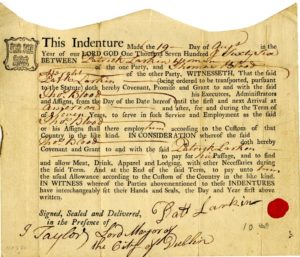
Chattel Slavery Legalized
In the year 1705, the Virginia General Assembly passed a law which transformed black indentured servants into slaves: the Virginia Slave Act of 1705 condemned many men, women, and children to a lifetime of slavery, even if they were only days away from being freed of their indentured status.
Before the Slave Act of 1705 was enacted, indentured servants over the age of 19 had to work for five years before achieving freedom (indentured servants under the age of 19 had to work until they reached the age of 24).
Virginia was the first colony to define the status of slaves in explicit legal terms. According to the colony’s 1705 law, all blacks, mulattoes, and Native Americans, all non-Christian persons brought into the colonies as servants (even should they later convert to Christianity) were considered slaves. The law went on to state that all slaves “shall be held to be real estate.”
Freedom Dues
Like slaves, servants could be bought, sold, or leased. They could also be punished by whipping. Unlike slaves, however, servants were allowed to own property, and, if they survived their term of service, received their freedom along with “freedom dues.” The law required masters to provide white servants whose indentured time was up with ten bushels of corn, thirty shillings in money or goods, one well fixed musket and 50 acres of land.
Cite: Edmund S. Morgan – American Slavery, American Freedom: The Ordeal of Colonial Virginia
The Declaration of Independence
The Congress formally adopted the Declaration of Independence–written largely by Jefferson–in Philadelphia on July 4, a date now celebrated as the birth of American independence. (see history.com)
- In the original list of grievances against King George III, future President Thomas Jefferson wrote that “he has waged cruel war against human nature itself, violating its most sacred rights of life and liberty in the persons of a distant people who never offended him, captivating and carrying them into slavery in another hemisphere, or to incur miserable death in their transportation thither.” Jefferson, along with forty of the original 57 signers, were slaveowners.
- A passage condemning the slave trade was removed from a rough draft of the Declaration of Independence due to pressure from both northern and southern slave holding delegates.
- One of the complaints against King George III was that, “He has endeavoured to bring on the inhabitants of our frontiers, the merciless Indian Savages whose known rule of warfare is an undistinguished destruction of all ages, sexes and conditions.” Ironically and tragically, certain U.S. state governments, as well as the U.S. federal government, engaged in the practice of offering money for scalps – which became a booming business, and was a likely origin of the “redskins” label used for Natives.
Land Ordinance Act of 1785
Congress set the minimum amount of land that could be purchased at one section—640 acres—and the purchase price at one dollar per acre. Small purchases on credit were not allowed. The $640 minimum purchase placed the cost of western lands far outside the budget of most U.S. citizens. Most of the lands went instead to wealthy land speculators, who were also given the option of buying on credit. The speculators bought lands from the government, divided them up, and then resold them to small farmers at a profit.
This act created rules for the survey, sale, and settlement of public domain. It also created “townships”; reserving a portion of each township for a local school. From these “land grants” eventually came the U.S. system of “land grant colleges,” the precursor to the state public universities that exist today.
Cite: Compiled by Elaine Rector as part of CFEE (Coaching for Educational Equity), contact elrector@comcast.net (Revised May 16, 2010)
The 1785 Land Ordinance Act, which offered 640 acres at $1 per acre, was only available to white people. The nearly 100,000 white people who came to California after the end of the Mexican-American War were allowed to claim and own “free soil”, while slaves and free black people were banned from doing so.
Cite: Fourth Economy and The Color of Wealth
First Native American Reservations
The U.S. established its Native American reservation. The policy dealt with each tribe as an independent nation. If tribes did not voluntarily move to reservations the government began forcefully removing people from their tribal land.
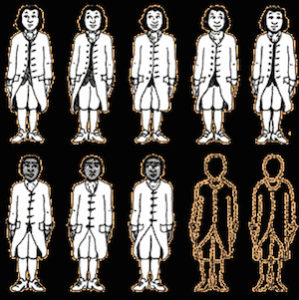
The Three-Fifths Compromise
Article I, Section 2 of the U.S. Constitution states: “Representatives and direct Taxes shall be apportioned among the several States which may be included within this Union, according to their respective Numbers, which shall be determined by adding to the whole Number of free Persons, including those bound to Service for a Term of Years, and excluding Indians not taxed, three fifths of all other Persons.” The “other Persons” were slaves.
The 1787 Constitutional Convention addressed the apportionment in the House of Representatives and the number of electoral votes each state would have in presidential elections based on a state’s population. The Southern states wanted to count the entire slave population. This would increase their number of members of Congress. The Northern delegates and others opposed to slavery wanted to count only free persons, including free blacks in the North and South.
The three-fifths clause was part of a series of compromises enacted by the Constitutional Convention of 1787. The most notable other clauses prohibited slavery in the Northwest Territories and ended U.S. participation in the international slave trade in 1807. These compromises reflected Virginia Constitutional Convention delegate (and future U.S. President) James Madison’s observation that “…the States were divided into different interests not by their…size…but principally from their having or not having slaves.”
When Constitutional Convention delegate Roger Sherman of Connecticut proposed that congressional representation be based on the total number of inhabitants of a state, delegate Charles Pinckney of South Carolina agreed saying “blacks ought to stand on an equality with whites….” Pinckney’s statement was disingenuous since at the time he knew most blacks were enslaved in his state and none, slave or free, could vote or were considered equals of white South Carolinians. Other delegates including most notably Gouverneur Morris of Pennsylvania argued that he could not support equal representation because he “could never agree to give such encouragement to the slave trade…by allowing them [Southern states] a representation for their negroes.”
With the convention seemingly at an impasse Charles Pinckney proposed a compromise: “Three-fifths of the number of slaves in any particular state would be added to the total number of free white persons, including bond servants, but not Indians, to the estimated number of congressmen each state would send to the House of Representatives.” The Pinckney compromise was not completely original. This ratio had already been established by the Congress which adopted the Articles of Confederation in 1781 as the basis for national taxation.
Although the three-fifths compromise and others regarding slavery helped hold this new fragile union of states together, many on both sides of the issue were opposed. James Madison and Edmund Randolph of Virginia used the phrase “Quotas of contribution” to argue that slaves should be fully counted, one for one, and opposed the compromise.
Northern opponents correctly pointed out that slaveholding states had more representatives than if only the free white population was counted. By 1793, slaveholding states had 47 congressmen but would have had only 33 if not for the compromise. During the entire period before the Civil War slaveholding states had disproportionate influence on the Presidency, the Speakership of the House of Representatives, and the U.S. Supreme Court because of the compromise. By the 1830s abolitionists such as William Lloyd Garrison of Massachusettsused the clause in their argument that the Federal government was dominated by slaveholders.
The three-fifths clause remained in force until the post-Civil War 13th Amendment freed all enslaved people in the United States, the 14th amendment gave them full citizenship, and the 15th Amendment granted black men the right to vote. (Portions of this description were copied from Malik Simba’s article on blacklist.org).
U.S. Constitution Ratified
The U.S. Constitution was ratified with the provision that the slave trade continue for another 20 years. It required states to aid slaveholders in the recovery of fugitive slaves.
Call for Homogeny
The second Federalist Paper, written by founding father, John Jay, expresses a concern with dangers of foreign force and influence and a view toward a country occupied by a population with important similarities:
Providence has been pleased to give this one connected country to one united people a people descended from the same ancestors, speaking the same language, professing the same religion, attached to the same principles of government, very similar in their manners and customs…
Occupying and Dispersing Native Land in the Northwest Legalized
The Northwest Ordinance was passed. It created a system of government and specified how this territory would become states. It assumed that the United States had the right to occupy, give away or sell land that was already occupied by Native peoples.
U.S. Constitution Ratified
The Constitution is ratified by all states after agreement to the Three-Fifths compromise (see 1787).
Free Whites Offered Citizenship
The Naturalization Act of 1790 was the first statute in the United States to codify naturalization law. Alternately known as the Nationality Act, the Naturalization Act of 1790 restricted citizenship to “any alien, being a free white person” who had been in the U.S. for two years. In effect, it left out indentured servants, slaves, and most women. This implied that black and, later, Asian immigrants were not eligible to be naturalized, but it said nothing about the citizenship status of non-white persons born on American soil. Subsequent nineteenth-century legislation included a racial requirement for citizenship.
The Naturalization Act set the criteria for naturalization to two years of residency, proof of good moral character, and an oath to support the Constitution. It also mandated that one must “absolutely and entirely renounce and abjure all allegiance and fidelity to every foreign Prince, Potentate, State or Sovereignty.” Despite its generous terms extending citizenship to all children of citizens, it denied the right to naturalize to “persons whose fathers have never been resident in the United States.” The law’s use of the phrase, “free white person,” also excluded blacks and immigrants of other races from being eligible for citizenship.[1] In 1795, as anti-immigrant feeling began to grow, the necessary period of residence was increased to five years. Without the right to naturalize, immigrants would not be able to vote and would have no political voice or power. (See updated Nationality Act of 1952)
Free Education for Poor White Children
Pennsylvania’s state constitution calls for free public education for poor children (whites only). It is expected that rich people pay for their childrens’ schooling, but educating poor whites will help society.
1800’s
1803The Louisiana Purchase
- Thomas Jefferson wanted control of the Mississippi River which directly and indirectly drains 44 states. He saw the value of “free transit of the Mississippi to the sea” for better and quicker trade routes.
- James Monroe and Robert R. Livingston traveled to Paris to negotiate the purchase. It was the largest territorial gain in U.S. history, stretching from the Mississippi River to the Rocky mountains and doubled the size of the U.S.
- It was purchased from Napoleon for $15,000,000 (worth $16 billion today) as he needed the money because he was afraid he might have to go to war with the United Kingdom.
- It included Arkansas, Missouri, Iowa, Oklahoma, Kansas and Nebraska and portions of what is now Minnesota, North Dakota, South Dakota, New Mexico and Texas, Montana, Wyoming, Colorado and Louisiana (including New Orleans).
The Indian Removal Act
The Indian Removal Act was signed into law by President Andrew Jackson on May 28, 1830, authorizing the president to grant unsettled lands west of the Mississippi in exchange for Indian lands within existing state borders. A few tribes went peacefully, but many resisted the relocation policy. During the fall and winter of 1838 and 1839, the Cherokees were forcibly moved west by the United States government. Approximately 4,000 Cherokees died on this forced march, which became known as the “Trail of Tears.”
The Trail of Tears
In 1838, President Martin Van Buren sends federal troops to march the remaining southern Cherokee holdouts 1,200 miles to Indian territory in the Plains. Disease and starvation are rampant, and thousands die along the way, the tortuous journey inspiring the nickname “Trail of Tears.”
A group of Seminoles, however, refuses to leave and hunkers down in Florida. They fight federal troops for almost a decade before their leader is killed and they finally surrender.
Irish Immigration Wave
Irish immigration increases due in part to the Irish potato famine. Called the “2nd Wave of Immigration” this time period sees entire families, not just Irish men, coming to the U.S. In the 1840’s over a million Irish arrive, comprising nearly half of all immigrants at the time. Irish Catholics in New York City struggle for local neighborhood control of schools as a way of preventing their children from being force-fed a Protestant curriculum.
Texas Annexed: Citizenship for Free Whites and White Mexicans
U.S. annexes Texas with full citizenship rights for free Whites and “White Mexicans” residing prior to 1845. The term “White Mexicans” refers to fair-skinned descendents of the Spanish without Indian heritage or appearance.
Mexican-American War
President James Polk ordered the invasion of Mexico starting the Mexican-American War.
The Treaty of Guadalupe Hildago
- Mexican-American war (1845-1848) ends with Mexico ceding half of its land to the United States for $15 million. This includes California, northern Arizona, New Mexico, Nevada, Utah, Oklahoma, Kansas, Wyoming and parts of what is now Colorado.
- This land is home to a quarter million Native Americans and 80,000 Spanish speaking residents.
- The U.S. gains a third of its land mass.
- The treaty maintains that the land belonging to Mexican Americans is protected under the law, but later in 1850, citizenship rights are turned over to states rights.
Implimentation of Reform Schools
Massachusetts Reform School at Westboro opens. Children who had refused to attend public schools are
sent here. This begins the long tradition of “reform schools,” combining education with the juvenile justice system.
Foreign Miners Act
The California Legislature passes the Foreign Miners Tax, requiring non-U.S. born miners to pay a monthly $20 tax. This is the first anti-Chinese legislation in California.
Organic Act of New Mexico Territory
- The Organic Act of New Mexico Territory grants full citizenship to “Free Whites” and Mexican citizens as covered by the 1848 Treaty of Guadalupe Hidalgo.
- It also asserts that no Indian may be a citizen.
- In addition, this act sets aside sections of land in every township to create and finance a public school system throughout the territory.
Indian Redefined
A California statute defines an Indian as having one-half “Indian blood” and allowes white men to force Indians into unpaid labor for vagrancy. In 1851 the definition is changed once again to someone having one fourth or more “Indian blood”. Many local laws are passed to restrict what Indians and “Half-Breeds” can do.
The Indian Appropriations Act of 1851
As white settlers continue westward and need more land, Indian territory shrinks — but there is no more land for relocating them
In 1851, Congress passes the Indian Appropriations Act which creates the Indian reservation system and provides funds to move Indian tribes onto farming reservations and hopefully keep them under control. Indians are not allowed to leave the reservations without permission.
Testimony by POC Against Whites Is Outlawed
An extensive body of discriminatory legislation is enacted in California including restrictions which outlaw testimony by African Americans, Chinese and Native Americans against Whites in any court of law.
Josefa Segovia Hanged for Defending Herself
Josefa Segovia is lynched in Downieville, CA. She is accused of murdering an anglo miner who attempts to assault her after breaking into her home. She pleads self-defense but is charged with murder. Her jury is made up of the miner’s friends. Her racial status most assuredly contributed to her death by hanging at the hands of a white mob.
Massachusetts Compulsory Education
Massachusetts passes the first compulsory education law to make sure that the children of poor white immigrants get “civilized” by learning obedience and restraint. Education is inteneded to help them became good workers instead of contributing to social upheaval.
Dred Scott v Sanford
U.S. Supreme Court’s Dred Scott Decision declares Blacks to be African, not U.S. Citizens. It rules Missouri Compromise’s ban on slavery in certain territories is unconstitutional and reaffirms fugitive slave laws.
Irish Secure Whiteness by Oppressing Blacks
In his book, How the Irish Became Whites, Noel Ignatiev describes how an oppressed class of immigrants, Irish Catholics, changed. They previously had lived and worked with “Free Blacks”. However, by this time they start to collaborate in the oppression and discrimination against another “race,” Africans in America. From being oppressed themselves they start to secure their place in the white protestant dominant culture.
The Homestead Act of 1862
- 246 million acres of land are given away.
- To obtain land, one must be a head of household over 21 and a white person “in good standing”,live on the land for 5 years (or purchase it for a small fee) and build a 12’x14′ structure.
- It created the official policy for U.S. soldiers to wage war on the indigenous nations of the west to protect the white settlers encouraged to take their land.
- There are 46 million whites alive today who benefited from this act.
Lorem Ipsum
Lorem Ipsum
Contract Labor Legalized
Congress legalizes the importation of contract laborers through the Contract Labor Law.
The Long Walk
Thousands of Navajo Indians endure the “Long Walk,” a three-hundred mile forced march from a southwest Indian Territory to Fort Sumner, New Mexico.
“Kill the Indian, Save the Man”
Congress makes it illegal for Native Americans to be taught in their native languages. Native children, as young as four years old, are taken from their parents and sent to Bureau of Indian Affairs off-reservation boarding schools. Richard Henry Pratt, U.S. Army officer and educator, sums up the schools’ mission: “Kill the Indian in him, and save the man.”
End of Civil War/Passing of Thirteenth Ammendment
The Civil War ends and the Thirteenth Amendment, banning slavery in the United States, passes by referendum in Oregon and throughout the Union states.
Certain Tribes Treated as Defeated Civil War Enemies
The Cherokee, Choctaw, Chickasaw, Creek and Seminole tribes, who had been forced to relocate to the Oklahoma Indian Territory, allied themselves with the South during the Civil War. Following the war, the U.S. government looked upon these tribes as defeated enemies. This animosity combines with increasing pressure to open up more Indian land leading to reccurring conflict.
Formation of Secret Organizations (KKK)
Ex-Confederates, to regain some sort of control during Reconstruction, form secret organizations that use intimidation and terrorism against Blacks and unionists. Names like Pale Faces, Sons of Midnight and Knights of the White Camellia were used. A group forms in Pulaski, Tennessee named the Ku Klux Klan, which grows to be the largest and best known of the groups opposing Reconstruction governments and attempts by freed Blacks to receive their rights.
Common School Act Reinforces Segregation
California enacts the Common School Act excluding Indians, Blacks & “Mongolians” from public school, but does allow local school boards to establish separate schools for such children. Although persons of Mexican descent are considered “white” under state law, de facto segregation is prevalent due to local practices of drawing school attendance lines to correspond with residential segregation.
Fourteenth Amendment
- The Fourteenth Amendment, endowing African Americans with citizenship, passes throughout the country.
- A clause in the 14th Amendment, “excluding Indians not taxed”, prevents Native American men from receiving the right to vote.
- Though this amendment establishes full citizenship rights for people of Mexican heritage born in the U.S., often the Indian heritage of Mexicans is used to exclude and deny them rights.
Fifteenth Amendment
The Fifteenth Amendment, granting black men the right to vote, is added to the U.S. Constitution despite failing to pass in both Oregon and California.
Indian Appropriations Act of 1871
The Indian Appropriations Act is a continuation of President Grant’s Peace Policy. This act stipulates that the US government will stop treating Plains Indians as ‘an independent nation, tribe, or power’. Instead, the act states that Plains Indians should be treated as wards of the state. A ward is a child who is put under the care of an adult guardian. Therefore, this act suggests that Plains Indians needed to be cared for as if they are children.
The Indian Appropriations Act makes it easier for the government to take away Plains Indian land, and means Plains Indians will no longer be able to form treaties with the US government.
Asians Blamed for Crime and Drug Use
A California Senate committee investigates the “social, moral, and political effect of Chinese immigration.” Asian immigrants are blamed for crime and drug use and therefore they are considered “undesirables.”
Reconstruction Ends
Reconstruction ends in 1877 when federal troops, which had occupied the South since the end of the Civil War, are withdrawn. Southern Whites regain political control of the South and lay the foundations of legal segregation and white supremacy.
Chinese Exclusion Act
Ignoring the crucial role Chinese immigrants played in constructing the infrastructure of the West, Congress passed the Chinese Exclusion Act. It suspended further Chinese immigration until 1892. It also made all Chinese immigrants ineligible for citizenship and barred them from several professions including mining.
The Indian Appropriations Act of 1889
After years of trying to open Indian Territory, President Grover Cleveland, on March 2, 1889, signed the 1889 Act which officially opened the Unassigned Lands to white settlers under tenets of the Homestead Act. However, under a section in this original act, those who entered these unassigned lands illegally, before their respective racing times as designated in the President’s opening proclamation, would be denied the rights to the lands they claimed. These people were termed “Sooners,” with this section of the act being termed as the “sooner clause.” But there was growing political pressure to open these unassigned lands to settlement quickly. Thus, later in 1889, an amendment to the Indian Appropriations Act allowed President Benjamin Harrison to be involved in this historical bill as well, proclaiming unassigned lands were open for settlement under much less stringent rules.[1]
First Federal Immigration Station Opened
First federal immigration station opens by order of President Benjamin Harrison on Ellis Island in New York harbor. Prior to 1890, individual states regulated immigration. Not all immigrants had to go through the rigorous screening. First and second class passengers were quickly processed with only a cursory inspection aboard ship, but passengers who arrived in steerage were scrutinized closely and often rejected for admission to the U.S.
Boomers and Sooners
A cannon’s boom unleashes the largest land rush the U.S. has ever seen. An estimated 100,000 settlers race to claim plots of land in the northern Oklahoma Territory known as the Cherokee Strip. These “unoccupied lands” are made available to white settlers against the existing provisions of treaties with tribes who had been forced to relocate there. The “Boomers” wait for the signal, while the “Sooners” snatch Indian land before the official start of the race.
Separate But Equal
In the Plessy v. Ferguson decision, the U.S. Supreme Court rules that Louisiana has the right to require “separate but equal” railroad cars for Blacks and Whites. This decision means that the federal government officially recognizes racial segregation as legal. One result is that southern states pass laws requiring racial segregation in many different areas of life including public schools.
Spanish-American War
The Spanish-American War begins with a naval blockade of Cuba and attacks on the island. The four-month conflict ends with Cuba’s independence and the U.S. acquisition of Puerto Rico and Guam. Though it is assumed that these new territories would become states, their language and racial composition make them unacceptable to some people as full members of the country. Instead they are seen as and remain territories of the U.S. empire.
U.S. Annexes Hawaii in Hostile Takeover
The United States annexes Hawaii at the urging of American plantation owners who exert tremendous power over the indigenous people. Queen Liliuokalani is overthrown with U.S. support. Hawaii is made a territory in 1900, and Sanford Dole becomes its first governor. Racial attitudes and party politics in the United States defer statehood until a bipartisan compromise links Hawaii’s status to Alaska, and both become states in 1959.
Chinese Children Born in U.S. Recognized as Citizens
The U.S. Supreme Court recognizes children born in U.S. of Chinese parents as citizens.
1900’s
1901Lorem Ipsum
Lorem Ipsum
Lorem Ipsum
Lorem Ipsum
Lorem Ipsum
Lorem Ipsum
Lorem Ipsum
Lorem Ipsum
The Immigration and Nationality Act of 1952
(The McCarran-Walter Act) stated that naturalization was extended to people of good moral character and “attached to the principles of the Constitution.” (See Naturalization Act of 1790, modified again by the Immigration and Nationality Services Act of 1965 and the Immigration Act of 1990)
Lorem Ipsum
Lorem Ipsum
